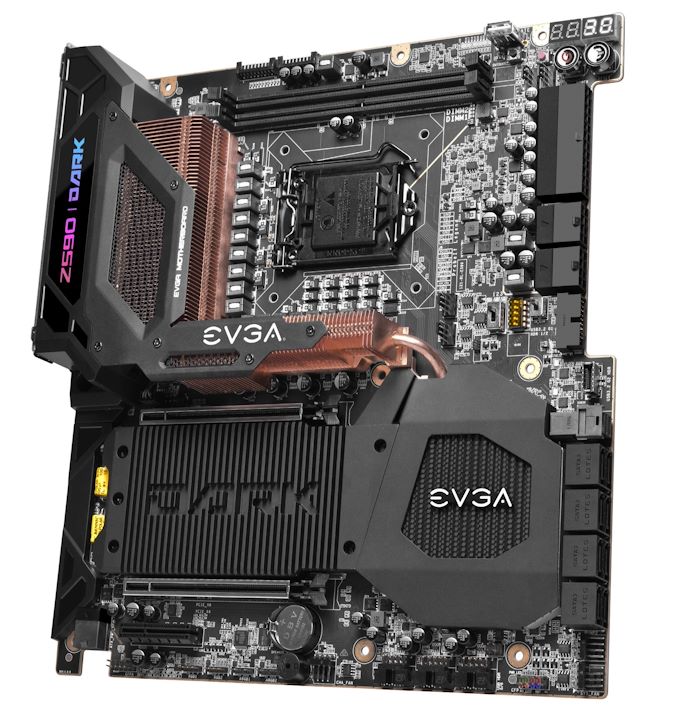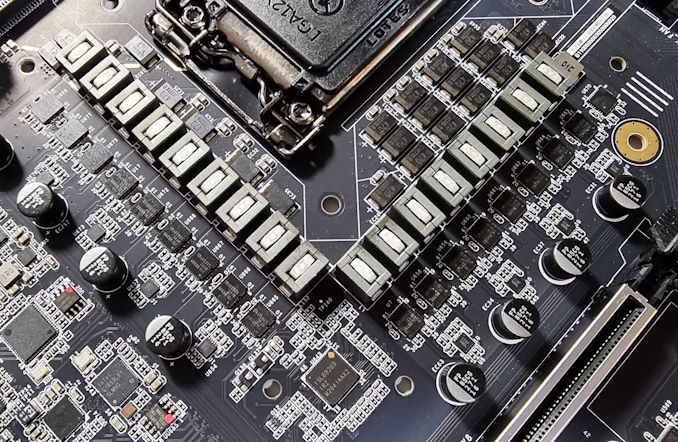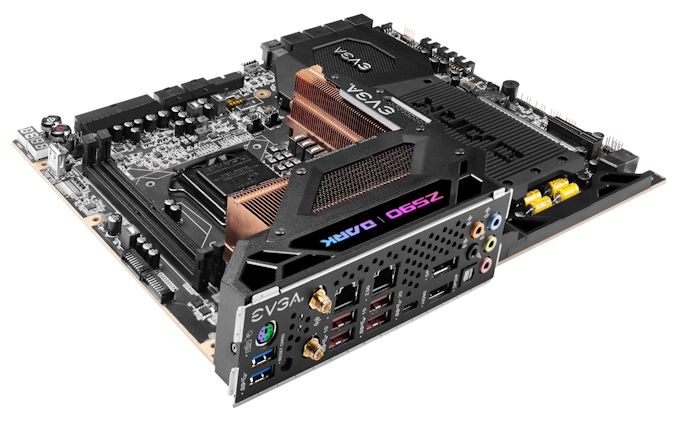The EVGA Z590 Dark Motherboard Review: For Extreme Enthusiasts
by Gavin Bonshor on October 15, 2021 9:00 AM ESTConclusion
We recently reviewed EVGA's first AMD Ryzen motherboard, the X570 Dark, and we were highly impressed with the performance levels on offer. Now it's our time to see how EVGA does in more familiar territory – Intel motherboards – and give our thoughts on the Z590 Dark. Ultiamtely we're looking at an enthusiast-grade motherboard designed for pushing CPUs beyond their limits on extreme cooling methods, and not many motherboards are capable of that.
Many of the EVGA Z590 Dark's features are aimed at overclocking, including an overclocker's toolkit with plenty of features to talk about. Particular highlights include a three-way BIOS selector switch – yes, this board has three BIOS ROM chips if a user manages to corrupt two of them. As well, it offers a slow mode dip switch, PCIe on or off dip switches, and a pair of EVGA Probelt voltage monitoring headers. Even the transposed LGA1200 CPU socket is mounted this way to aid overclocking, as this allows extreme overclocks better access to mount CPU pots.
Above the socket is a pair of horizontally mounted memory slots supporting DDR4-5333, with a maximum combined capacity of 64 GB. EVGA also includes an LN2 mode within the firmware that helps alleviate cold boot bugs when using sub-ambient cooling methods. This also allows for more CPU VCore to be put through; this isn't meant for everyday users, and only experienced users should play about with these settings.
Despite being an overclocking-focused motherboard, the Z590 Dark has plenty for regular users, as well. This includes three M.2 slots, a PCIe 4.0 x16 slot, one PCIe 3.0 x4, and one PCIe 3.0 x4 with support for SATA drives. Unfortunately, the third M.2 slot does share bandwidth with the half-length PCIe 3.0 x4 slot, but EVGA includes two full-length PCIe 4.0 slots operating at x16 and x8/x8 to satisfy users. Other storage options include a PCIe 3.0 x4 U.2 slot, which is rare in and of itself, and a total of eight SATA ports, six of which support RAID 0, 1, 5, and 10 arrays.
For connectivity, EVGA uses dual Intel I225-V 2.5 GbE controllers and an Intel AX201 Wi-Fi 6 CNVi, which provides plenty of options. We're a tad disappointed EVGA didn't include Wi-Fi 6E for the price, and we're not sure why it didn't. However, it does have one of Z590's natively supported USB 3.2 G2x2 Type-C ports, along with four USB 3.2 G2 Type-A and two USB 3.2 G1 Type-A ports on the rear panel. Audio is also decent, with a Realtek ALC1220 HD spearheading things and EVGA's NU Audio SV3H615 amplifiers help bolster things.
Focusing on performance, and the EVGA Z590 Dark did very well in our system tests, with a spectacular showing in our DPC latency and non-UEFI POST time testing. In our computational and game tests, the EVGA performed competitively with other Z590 models we've tested.
With overclocking being one of the touted strong points of the EVGA Z590 Dark, we did manage to achieve 5.4 GHz all-core at 1.541 V on the CPU VCore with the help of the EVGA OC Robot. As expected, due to the enormous amount of CPU Vcore voltage applied, we instantly encountered thermal throttling, even with a minus-three offset set for AVX workloads. In our manual testing from 4.7 GHz to 5.0 GHz, VDroop control was tight, but beyond this, that's when things got a little awry, with much more CPU Vcore applied at full-load than we set within the firmware. Performance in our VRM thermal testing was also respectable, but we would have liked to see better performance given the board's actively cooled power delivery.
Final Thoughts: Dark By Design
We've now reviewed three of the big four overclocking motherboards designed for Rocket Lake, including the GIGABYTE Z590 Aorus Tachyon, the ASRock Z590 OC Formula, and now the EVGA Z590 Dark. And so far, the consensus is this: all of them will give solid performance when paired with an Intel Core i9-11900K.
Meanwhile, as this is our last Z590 motherboard review, it's nice to end things with one of the more interesting ones. It's no secret that EVGA and Vince 'KINGPIN' Lucido are stalwarts within the industry, and they certainly know how to deliver an overclocking motherboard with lots of functionality. The EVGA Z590 Dark is no exception to this. It uses its large 21-phase power delivery to good effect, but in reality, it's it's a 17 to an 18-phase design by most standards; EVGA has added all of its elements, including VCSSA, VCCIO, VCCIO2, and VDDR phases, to provide a bigger number for marketing purposes. There's of course nothing wrong with this in practice, but it is operating at 8+1+1 with doublers, and it has to be stated constructively.
The EVGA Z590 Dark has an MSRP of $600, and EVGA is currently selling it at just that price on their website. For perspective, the GIGABYTE Z590 Aorus Tachyon runs for $530, and the ASRock Z590 OC Formula is $550; so the Dark ends up being the most expensive of the trio.
Ultimately, for users looking for a solid motherboard for a simple system, a cheaper high-end Z590 motherboard will offer much more in terms of both features and controller sets for the price. Still, when it comes to extreme overclocking, a regular board won't be anywhere near as good as the EVGA Z590 Dark, and that's a role that EVGA's board is serving well.













27 Comments
View All Comments
gavbon - Saturday, October 16, 2021 - link
Value is all relative to what a user is willing to spend. For extreme overclocking, that's dependant on the qualityAlistair - Friday, October 15, 2021 - link
Quick! Buy it 2 weeks before it is obsolete! Hurry! ;)Silver5urfer - Friday, October 15, 2021 - link
Obsolete ? LGA1700 ADL is going to be a generation first product on DDR5 with Gear 4 and Gear 2, on top of new trash cores shoved in because of high power consumption. Plus a basic PCIe5.0 for GPU X16 only. Yeah more DMI and more lanes but questionable Intel Hardware Scheduler on top of the big little BS first adoption on top. Plus the added cost for all the new tech.If we follow the leaks ADL barely matches Zen 3 in SMT and perhaps in ST boost how it translates to real world ? Gotta see, RKL was also like that but came at huge power spike and not much in SMT. This new ADL has inferior cores going to magically beat in real workloads ? Nah.
Nope this platform is not Obsolete only issue is PCIe NVMe SSD slots aren't there and must use PCIe slot and RAID them. If used with 10th gen then PCIe3.0 will be a negative on the GPU lane when used with NVMe SSDs.
Alistair - Friday, October 15, 2021 - link
You can buy it using DDR4 and it is in no way inferior, if you don't want DDR5. The new big cores are just better than Rocket Lake big cores, so who cares about the small cores, those are just extra. With Intel you can even disable any cores you don't want. Why are you comparing to AMD when we are talking about Z590 being obsolete vs the latest Intel, AMD has nothing to do with my comment. A lot of funny responses in your comment.Silver5urfer - Friday, October 15, 2021 - link
It's not obsolete is the fact gauging by the performance it offers. The fact that AMD was mentioned is because on how RKL was compared to it and had ST advantage but nothing in SMT and huge power draw.Small cores no one cares ? Are you drunk lol. Intel is screaming from their chest that these 8x Atom trash are better than SMT cores AND the fact on how the Cinebench leaks showed it barely reaches to AMD's top SKU in the same tests. And you think disabling those small cores is going to net you the performance boost that Intel is claiming, what a pathetic joke. Those cores are needed if you disable you lose SMT Multicore advantage. Period. AND finally DDR4 is Gear 2 by default there was a latest leak saying Gear 1 is maxed out at 3600MHz probably similar or could be worse than RKL IMC.
You took the AMD and other aspects and discarded everything related to being a new platform on top of the extra costs, done with your kind of garbo useless replies.
amnesia0287 - Friday, October 15, 2021 - link
Assuming anyone will be able to actually find them in stock. I wasn’t under the impression intel had solved the silicon shortages.Wrs - Sunday, October 17, 2021 - link
Oh come on, Z590 is at higher risk of obsolescence than a typical chipset. Every CPU supported is 14nm. You could be stuck between the power hungry RKL and the soon to be two generation lag of Comet Lake. Both already have problems comparing to Ryzen.LGA1700 should offer you the ability to reuse ddr4. The number of technologies being added is what obsolescence is about, no? The only thing to save Z590 from obsolescence is if ADL is trash, and you simply don't know that, not from the public leaks.
Flying Aardvark - Sunday, October 17, 2021 - link
That makes no sense. RKL is the fastest gaming CPU where it counts, minimum frames per second / 99th percentile. https://www.tomshardware.com/reviews/best-cpus,398... Take a look for yourself. Who cares if it's 14nm? Larger process nodes have their advantages as well. Performance is what matters. If you're looking to save on energy, buy yourself a tablet. The only thing obsolete is whatever you're running in your rig today instead. Ryzen has plenty of problems, you're just not informed. Stay salty, poor boy.Wrs - Sunday, October 17, 2021 - link
Obsolescence is about what's around the corner, not what you have today. I just think buying any Z590 today is asking for buyer's remorse. Around the corner, we're expecting expanded cache Ryzens for AM4 - which may not be much except for gaming - and ADL on Z690. ADL consists of two new cores on a finer process (I consider it coequal with Zen 3's 7nm), translating to a higher overall core/thread count and cache, and ITD with all its potential game optimizations. Unless ADL has a poor showing or developers don't support ITD, won't ADL make Z590 suddenly feel lackluster? It could be a mild Pentium 4 moment.It's true that RKL holds pole position for most games right now. It's just that the edge over a 5800x is really small, the cost of that power budget is substantial, and many of us weigh other workloads too, including multitasking while gaming.
Silver5urfer - Monday, October 18, 2021 - link
As a platform probably yes because of only I/O - PCIe3.0 for CML and RKL gettin Gen 4 but at 8C max and insane ABT power spiking and heat. In terms of performance not yet. ADL is a brand new platform and with questionable core design it's already having a lot of news around DRM, Application optimizations and etc. Why should I pay for beta testing a product ? Esp when the DDR5 is so new and PCIe5.0 barely has any effect and the whole socket longevity along with Intel Thread Director drama and Win11 shenanigans ??Intel clearly lost their way. RKL was the first sign of that, IMC massively downgraded on that. With ADL DDR4 is not going to run at 4000MHz C15. It's not going to happen. The leaks show max of 3600MHz just like AMD, AM4 platform has a TON of issues, I was on the verge on pulling a trigger on Crosshair 8 Dark Hero but the USB drop out, WHEA issues, random PCIe issues, million AGESA updates. FCLK instability all these are there some of them only if you push the CPU but what's the point in buying a 16C or 12C processor and shoving it in an OC capable high VRM mobos likes of Aorus Master or Xtreme etc or even the X570 DARK and run it on all stock ?
All of these compound to one thing per my analysis, CML / RKL LGA1200 is a better mature platform to put money in for the next 5 years of it's life.